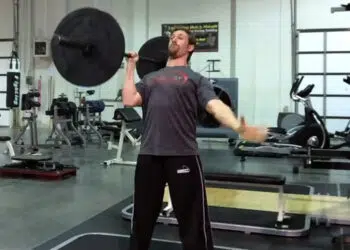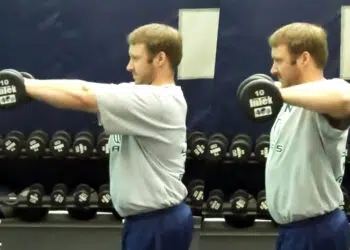Battle ropes may seem intimidating at first and make no mistake, it’s not an easy activity to partake in (at least not when done properly with decent intensity). However, that doesn’t mean you should ignore it, especially if you’re curious about the potential benefits of this exercise.
And as with any form of training, you don’t have to go all out at first. After all, everyone has to start somewhere, right? Battle ropes are a very good conditioning activity that improves upper body power and works the shoulders, arms, and more. We’ll show you how it’s done plus offer you some tips, provide a few variations, and offer some advice on how to incorporate it into your training.
Here’s a guide to battle ropes…
How To Do Battle Ropes
We’ve provided step-by-step instructions for battle ropes to help you maximize the effectiveness of this exercise. There are many different ways to do battle ropes, a few of which we’ve also provide details for. But the following instruction is for the basic, alternating variation.
- Hold the ends of the ropes and allow for a decent amount of slack but not too much.
- Get into an athletic stance with feet roughly shoulder-width apart, knees slightly bent, torso bent slightly forward, and keep your head straight looking forward. Also, make sure your core is tight.
- Keep your arms about shoulder-width or closer together with elbows slightly bent, then move your arms up and down nice and easy at a moderate tempo, in alternating fashion.
Battle Ropes Tips
- While we provided basic setup and form instructions, this will ultimately vary between individuals. Find a stance that allows you to perform this activity most efficiently.
- Remain upright with an athletic stance for the most optimal performance possibilities. Bending too far forward is also dangerous for the back and it’s not natural.
- You can vary the range of motion and speed to engages certain muscles better or to turn up the intensity. Shorter motions will involve more arms, while larger motions will engage more of the shoulders.
- Gripping too tight will wear you out pretty fast and it’s also not great for your wrist and elbow joints. So, take a firm but not overly tight grip.
- Not allowing for enough slack in the ropes will prevent you from using enough force during the movement, while also not allowing for a natural movement; which is stressful on the joints. Take a step into the ropes before you begin to ensure you have enough rope to work with.
Muscles Worked
While the delts will take a beating during battle ropes, there are various muscles involved in this exercise. Here’s a brief description of each one.
- Deltoid anterior – Front head of the shoulder flexes to lift the ropes.
- Brachialis – Splits its length between the forearm and upper arm. Known as the strongest elbow flexor.
- Brachioradialis – Muscles in the top and lateral side of the forearm.
- Biceps – Two headed upper arm muscles that flexes when the elbow bends. Biceps are stronger as a forearm supinator and pronator than flexor.
- Triceps – Antagonist to the biceps, the triceps is a three muscle group that straightens the arm from a flexed angle.
- Infraspinatus – Rotator cuff muscle brings motion and stabilization to the shoulder during various movements.
- Teres Minor – One fourth of the rotator cuff muscles, teres minor stabilizes the shoulder joint by keeping the head of the upper arm in the socket.
- Trapezius – Claiming its spot across the upper back near the neck, trapezius muscles are split into three groups – upper, middle and lower sections. Upper traps initiate upward movement of the scapula while the middle traps move it back and the lower traps draw it downward.
- Rectus abdominis – A set of stable abs is always necessary when it comes to resistance training. Your core muscles should be working overtime to maximize your other muscles during the movement and protect your lower back.
3 Battle Rope Variations
The alternating battle ropes are amazingly effective. However, you’d be leaving gains on the table by not utilizing some of the other variations that vary in difficulty. Now, we couldn’t possibly provide all of the variations as there are so many but here are some we think you’ll like.
Level Up Your Fitness: Join our 💪 strong community in Fitness Volt Newsletter. Get daily inspiration, expert-backed workouts, nutrition tips, the latest in strength sports, and the support you need to reach your goals. Subscribe for free!
1. Double whip battle ropes
This is similar to the basic alternating variation, however, this time you’re moving both arms up and down at the same time and not in an alternating fashion. You can also use a little momentum from the legs if you want to.
2. Battle squat jump rope slams
If you’ve ever wanted a reason to do the Hulk smash without looking silly, this is your opportunity. Battle rope squat jump slams are excellent for improving both upper and lower body power and explosiveness. You can use heavier ropes for these to replicate medicine ball slams.
3. Plank battle ropes
For this one, you get into a high plank position, although, you can do this in the conventional plank position with your forearm supporting your body weight. This variation really engages the core and helps to improve full-body stabilization.
Level Up Your Fitness: Join our 💪 strong community in Fitness Volt Newsletter. Get daily inspiration, expert-backed workouts, nutrition tips, the latest in strength sports, and the support you need to reach your goals. Subscribe for free!
Here’s an example of this exercise.
How To Incorporate Battle Ropes Into Your Training Routine
Because battle ropes are typically done in rapid fashion, it’s best to do them until you’re exhausted or for a specific amount of time.
For example, you can do 20 seconds on, followed by enough rest to where you can catch your breath before going another round. You can combine the different variations for one workout to focus on different aspects of development. Or you can utilize one variation and do 2-4 rounds to failure. The options are endless.
Introduce athletic movements such as moving side to side quickly, jumping jacks, alternating lunge jumps, etc. Include battle ropes during HIIT (high-intensity interval training) training to really scorch your fat cells, and take your conditioning to the next level. Battle ropes also make for an excellent finisher after a workout session.
Related: 20 Simple And Functional Workout Finishers For Muscle Gains, Strength, and Fat Loss
There’s no one way to do it so get creative and start off slow and light if you’re a beginner. Perfect the basics before moving on for safety and to maximize the effectiveness of this awesome activity.
Wrapping Up
Battle ropes is a great exercise that anyone can do to improve their fitness levels. And the great thing is, there are so many different variations that you’ll never become bored. Not to mention, it’s a suitable replacement on those days when you want something a little more exciting and intense compared to typical steady-state cardio sessions.
We hope this guide was helpful… now it’s time to get to work!
Interested in measuring your progress? Check out our strength standards for Jumping Jack, Squat Jump, Squat, and more.











